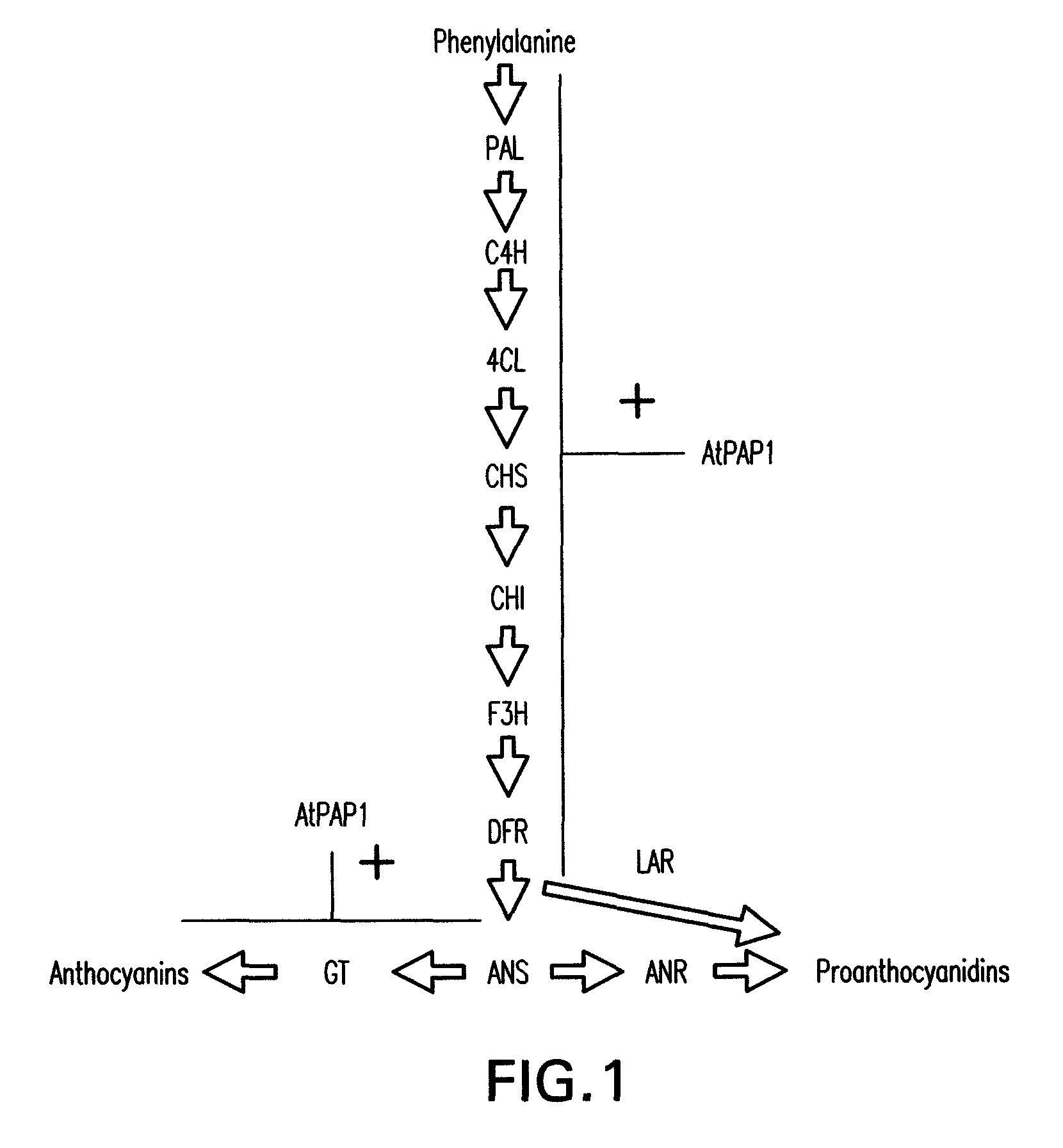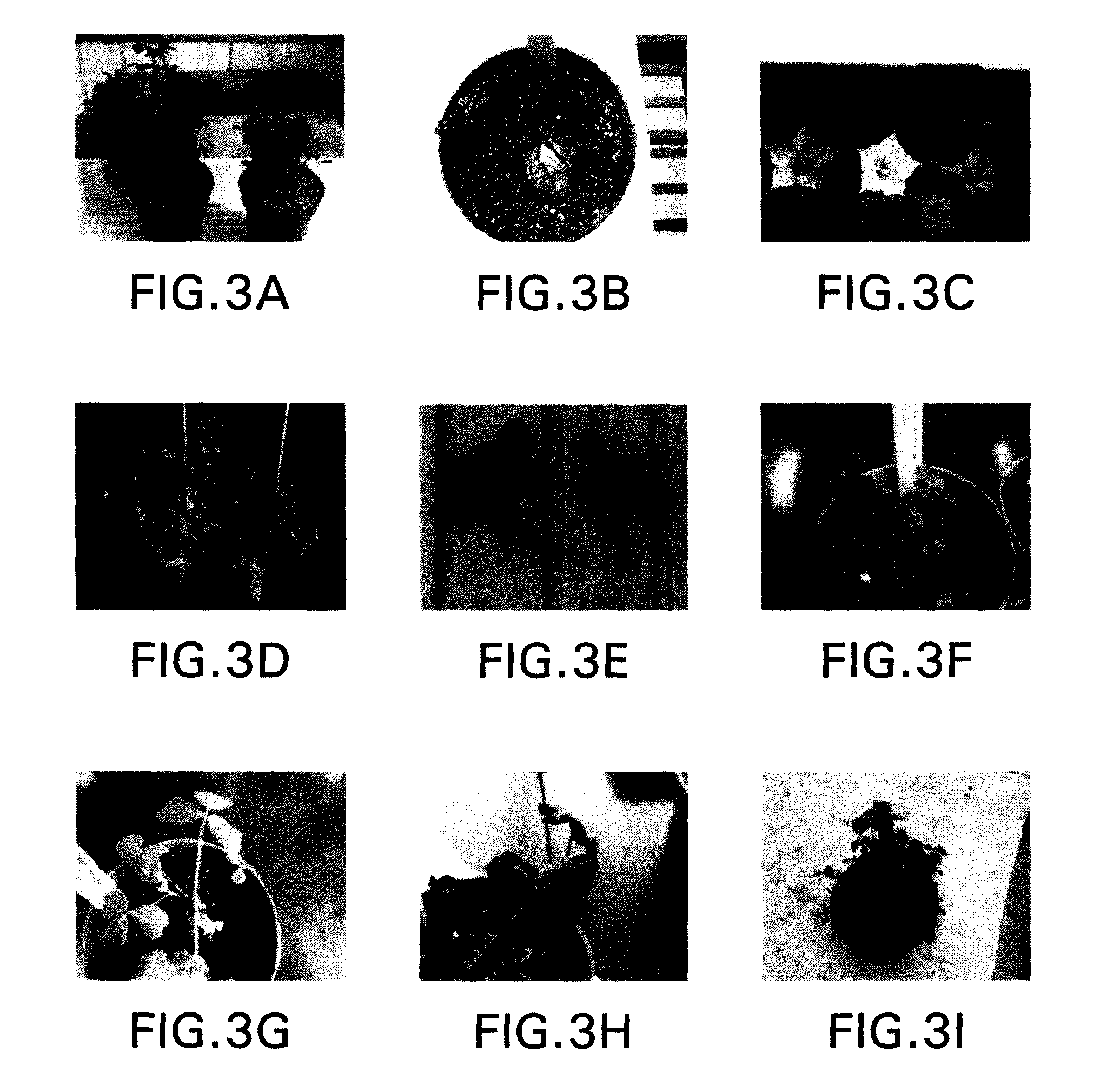Production of proanthocyanidins to improve forage quality
a technology of proanthocyanidins and forage quality, applied in the field of plant genetics, can solve the problems of premature necrosis and death of plants, failure to provide techniques for the application of this understanding, and the inability to take advantage of the otherwise excellent nutritional qualities of alfalfa and clovers
- Summary
- Abstract
- Description
- Claims
- Application Information
AI Technical Summary
Benefits of technology
Problems solved by technology
Method used
Image
Examples
example 1
The Arabidopsis PAP1 Myb Transcription Factor Does Not Induce Anthocyanin Production in Legumes
[0178]The PAP1 (producer of anthocyanin pigmentation) gene of Arabidopsis encodes a MYB transcription factor (Borevitz et al., 2000). The PAP1 gene of Arabidopsis is a global regulator of the anthocyanin biosynthetic pathway, and its ectopic expression in Arabidopsis results in a deep purple phenotype associated with accumulation of anthocyanins (Borevitz et al., 2000; Tohge et al., 2005). A similar phenotype is observed when AtPAP1 is expressed in tobacco (Borevitz et al., 2000; Xie et al., 2006), suggesting that AtPAP1 function might not be species-specific. During attempts to introduce anthocyanin as substrate for conversion into PAs in forage legumes, a 35S-AtPAP1 construct was introduced by Agrobacterium-mediated transformation into alfalfa, Medicago truncatula and white clover. Multiple independent transgenic lines were verified as expressing the PAP1 transgene, but the plants never ...
example 2
Identification of Medicago Anthocyanin Pathway Regulatory Genes
[0179]To overcome the above limitation in expressing PA's and / or anthocyanins in legumes including alfalfa, a bioinformatics search was undertaken to identify transcription factors from M. truncatula (a close relative of alfalfa) which might regulate anthocyanin synthesis in legumes in a similar manner to the effects of expression of AtPAP1 in Arabidopsis and tobacco. Since transcription factors are expressed at very low levels they are rarely found in traditional EST collections. Indeed, the Arabidopsis PAP1 and PAP2 genes were first identified using an activation tagging screen (Borevitz et al., 2000). Searches of the publicly available M. truncatula EST collections (e.g. Medicago truncatula Gene Index at Dana Farber Cancer Institute (www.compbio.dfci.harvard.edu / tgi / cgi-bin / tgi / gimain.pl?gudb=medicago) led to no Medicago sequences apparently homologous to Arabidopsis PAP1 or PAP2. The approach subsequently taken was t...
example 3
Plant Transformation and Visible Phenotypes Arising from LAP1 Expression in Transgenic Plants
[0184]Constructs harboring MtLAP1, MtLAP2 or GUS (for controls) were transformed into Medicago truncatula R108, Nicotiana tabacum and white clover (Trifolium pratense) using published protocols (Horsch et al., 1985; Thomas et al., 1990; Wright et al., 2006). Transgene DNA was isolated using the Dellaporta method (Dellaporta et al., 1983) and analyzed by qualitative PCR using 35S promoter- and transgene-specific primers. Plants were maintained in the greenhouse and allowed to self pollinate. In the case of the Medicago truncatula transformation, a total of 34 independent lines (each derived from a single embryo transformant) were obtained for the MtLAP1 and GUS transgenes, and 15 independent lines for the MtLAP2 transgene. MtLAP1 transformed into clover yielded 20 lines, while transformation of MtLAP1 into MtANR-expressing alfalfa (see below) yielded 20 independent lines (each line derived fr...
PUM
| Property | Measurement | Unit |
|---|---|---|
| weight | aaaaa | aaaaa |
| temperature | aaaaa | aaaaa |
| temperature | aaaaa | aaaaa |
Abstract
Description
Claims
Application Information
 Login to View More
Login to View More - R&D
- Intellectual Property
- Life Sciences
- Materials
- Tech Scout
- Unparalleled Data Quality
- Higher Quality Content
- 60% Fewer Hallucinations
Browse by: Latest US Patents, China's latest patents, Technical Efficacy Thesaurus, Application Domain, Technology Topic, Popular Technical Reports.
© 2025 PatSnap. All rights reserved.Legal|Privacy policy|Modern Slavery Act Transparency Statement|Sitemap|About US| Contact US: help@patsnap.com



